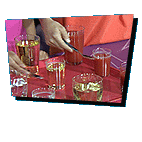 your results your results
Sent in by:
Brooke of Alberta, Canada and Nirav of Pleasanton, CA
Play it again, Sam.

- 3 glasses of each of 3 different sizes and shapes (9 glasses total)
- 4 glasses of the same size and shape
- different liquids like vinegar, water, milk, tomato juice, maple syrup, oil or apple juice
- spoons

- Check with a grown-up before you begin.
- In the ZOOMsci, Glass Xylophone, and in the online gizmo, Tunes & Spoons, you can experiment with the different sounds made by glasses holding different amounts of the same liquid.
- Now's your chance to experiment with other variables like the kind of liquid in the glass or the size and shape of the glass itself.
- First, find out if different kinds of liquids change the sound made by tapping the glass with a spoon.
- Pour the same amounts of different kinds of liquids into the same kind of glass. Try liquids that are thick and gooey like maple syrup as well as liquids that are runny like water.
- Tap the same spot on each glass. Do the different liquids produce different sounds? How are the sounds different?
- Touch the glass after you tap it with the spoon. Do the vibrations from each glass feel different? What is it about each liquid that might change the sound the glass makes?
- Next, find out if the shape or size of the glass makes a difference in the sound made by tapping the glass with a spoon.
- Pour the same amount of the same liquid into three glasses of different sizes and shapes. Tap each glass with the spoon. Does it make a different sound than the other glasses? How are the sounds different?
- Touch the glass after you tap it with the spoon. Do the vibrations from each glass feel different? What is it about the shape and size of the glass that changes the sound?
Ready for the science scoop? When an object vibrates, it sends a disturbance through the air in the form of waves. These are called sound waves. It's like when you drop a pebble into water and the waves ripple out in all directions. Sound waves in the air are sort of like waves in the water in the way that they move farther and farther out from the center where the disturbance was created.
When you tap a glass filled with liquid, the liquid slows down the vibrations or sound waves. Different liquids slow down the sound waves by different amounts. The differences in the sounds you hear are called pitch. The pitch of a sound depends on how fast the object making the sound vibrates (how fast the sound waves move away from the object.) A glass that vibrates slowly produces slow sound waves and a low pitch sound. A glass that produces a high pitch vibrates quickly, making sound waves move fast.
See how many different pitches you can make using glasses and liquids. Can you play a song with them? Give it a try and send your results to ZOOM!

Clara, age 11 of Bexley, OH wrote:
I just used water but at different levels and it made sounds that were higher when I had less water in them and sounds that were lower when I had more water in them. Also, I had a tall and a short glass and they were both filled up to the top and I tapped them and the taller one made a lower sound and the shorter one made a higher sound.
Nicole, age 13 of NY wrote:
I used water, syrup, and water as my liquids. I poured them in the same type of glass and they all sound the same.
Madeline, age 12 of Davison, MI wrote:
That the glass that had the most water was the lowest sound and the least water was the higher sound.
Marylin of Las Cruces, NM wrote:
It made these crazy sounds all over the place.
Ellie, age 11 of Colorado Springs wrote:
It was neat it made all different types of sounds!!!
Lily, age 11 wrote:
It was really cool because it sounded great! My little sis said that I should become a musician when I grow up.
Ethan, age 4 of Villa Park, IL wrote:
It was fun. I used milk, vinegar, water, and cherry juice. They made different sounds.
Mallory, age 10 wrote:
I tried the glass xylaphone part 2 and found out that when you wet your finger and go around the top of the glass it makes a squeaky noise but I aldo found out that it doesnt work on plastic glasses.
Amelia, age 5 of Centennial, CO wrote:
We tried using a wine glass with some water and some ice in it to make a sound when you rub your finger around the rim. It didn't make a sound.
Alyana, age 9 of Manchester, CT wrote:
I tried it when I was on Spring break it was very messy, but fun. I tried it with the same amount of diffent liquids and they didn't sound diffent and I thougt it was cool. Then I tried it with diffent amount of liquids. IT WAS FUN!!! TRY IT!!!
Briseida, age 11 of Houston, TX wrote:
When I performed the experiment, different sounds came from each of the glasses. Also, different kinds of liquids make different kinds of sounds.
|



